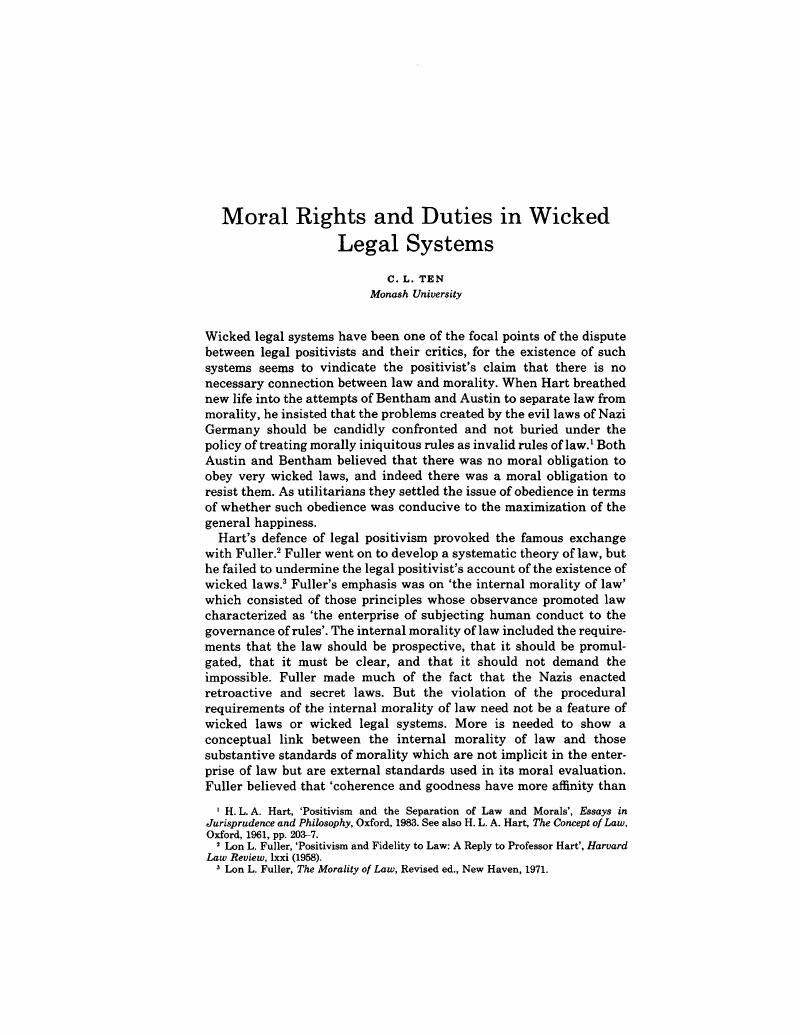No CrossRef data available.
Published online by Cambridge University Press: 26 January 2009

1 Hart, H. L. A., ‘Positivism and the Separation of Law and Morals’, Essays in Jurisprudence and Philosophy, Oxford, 1983CrossRefGoogle Scholar. See also Hart, H. L. A., The Concept of Law, Oxford, 1961, pp. 203–7.Google Scholar
2 Fuller, Lon L., ‘Positivism and Fidelity to Law: A Reply to Professor Hart’, Harvard Law Review, lxxi (1958).Google Scholar
3 Fuller, Lon L., The Morality of Law, Revised ed., New Haven, 1971.Google Scholar
4 Fuller, , ‘Positivism and Fidelity to Law’, 636Google Scholar. See also Fuller, , Morality of Law, ch. 4Google Scholar, and Hart's comments in Hart, H. L. A., ‘Lon L. Fuller: The Morality of Law’, Essays in Jurisprudence and Philosophy, pp. 351–3.Google Scholar
5 Hart, , ‘Positivism’, p. 74.Google Scholar
6 Fuller, , ‘Positivism and Fidelity to Law’, 659.Google Scholar
7 Dworkin, Ronald, Taking Rights Seriously, New Impression, London, 1984, esp. ch. 3 and pp. 338–53.Google Scholar
8 Hart, H. L. A., ‘Legal Duty and Obligation’, Essays on Bentham, Oxford, 1982, p. 151Google Scholar. See also Hart, H. L. A., ‘Legal Theory and the Problem of Sense’, Issues in Contemporary Legal Philosophy: The Influence of H. L. A. Hart, ed. Gavison, Ruth, Oxford, 1987, pp. 40–2.Google Scholar
9 Dworkin, Ronald, ‘A Reply by Ronald Dworkin’, Ronald Dworkin and Contemporary Jurisprudence, ed. Cohen, Marshall, Totowa, 1984, pp. 256–60.Google Scholar
10 For an interesting discussion of the view that not all obligations are moral obligations, see Sartorius, Rolf E., Individual Conduct and Social Norms, Encino, 1975, ch. 5.Google Scholar
11 Dworkin, , ‘A Reply’, p. 259.Google Scholar
12 Dworkin, Ronald, Law's Empire, London, 1986, esp. pp. 101–8Google Scholar. See also Dworkin, , ‘Legal Theory and the Problem of Sense’.Google Scholar
13 Dworkin, , Law's Empire, pp. 178–84.Google Scholar
14 Ibid., p. 106.
15 Ibid., p. 105.
To send this article to your Kindle, first ensure no-reply@cambridge.org is added to your Approved Personal Document E-mail List under your Personal Document Settings on the Manage Your Content and Devices page of your Amazon account. Then enter the ‘name’ part of your Kindle email address below. Find out more about sending to your Kindle. Find out more about saving to your Kindle.
Note you can select to save to either the @free.kindle.com or @kindle.com variations. ‘@free.kindle.com’ emails are free but can only be saved to your device when it is connected to wi-fi. ‘@kindle.com’ emails can be delivered even when you are not connected to wi-fi, but note that service fees apply.
Find out more about the Kindle Personal Document Service.
To save this article to your Dropbox account, please select one or more formats and confirm that you agree to abide by our usage policies. If this is the first time you used this feature, you will be asked to authorise Cambridge Core to connect with your Dropbox account. Find out more about saving content to Dropbox.
To save this article to your Google Drive account, please select one or more formats and confirm that you agree to abide by our usage policies. If this is the first time you used this feature, you will be asked to authorise Cambridge Core to connect with your Google Drive account. Find out more about saving content to Google Drive.